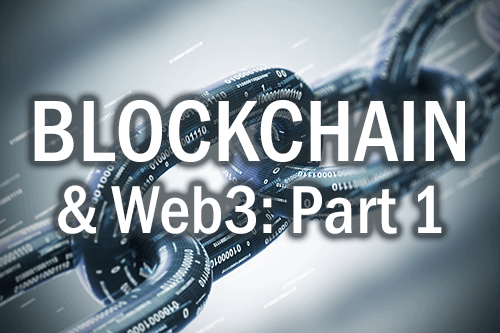| Part 2: Delving Deeper into Blockchain | Part 3: Web3 Emerging | Part 4: The Web3 and Blockchain FAQ
There has been a lot of buzz about blockchain over the past five years, and yet seemingly not much movement. Long, long ago I concluded that the amount of truth to the reported value of a new technology was inversely proportional to the level of din its hype made. But as with so much else about blockchain, it defies conventional wisdom. Blockchain is a bigger deal than is generally realized.
Basic Blockchain Definition and Introduction
(Source: Wikipedia): Blockchain is a peer-to-peer (P2P) or publicly decentralized ledger (shared distributed database) that consists of blocks of data bound together with cryptography. Each block contains a cryptographic hash of the previous block, a time stamp and a transaction date. Because each block contains information from the previous block, they effectively form a chain – hence the name blockchain.
Blockchain transactions resist being altered once they are recorded because the data in any given block cannot be altered retroactively without altering all subsequent blocks that duplicate that data. As a P2P publicly distributed ledger, nodes collectively adhere to a consensus algorithm protocol to add and validate new transaction blocks.
“A blockchain is a system of recording information in a way that makes it difficult or impossible to change, cheat or hack the system,” said Eric Frazier, senior solutions manager, Supermicro. “It is a digital ledger that is duplicated and distributed to a network of multiple nodes on the blockchain.”
Michael Fair, PiKNiK’s chief revenue officer and longtime channel expert added, “In the blockchain, data is immutable. It’s actually sealed within the network, which is monitored by the blockchain 24 x 7 x 365 days a year.”
Blockchain was created in 2008 under the apparent pseudonym, Satoshi Nakamoto. Its original use was to provide a public distributed ledger for the bitcoin cryptocurrency also created by the same entity. But the true promise of blockchain goes way beyond cryptocurrency. The downside is that blockchain operations are computationally intensive and tend to use lots of power. This issue will be covered in more detail later in the series.
Understanding “Decentralized”
The term decentralized is probably the most important tenet of Web3 and it is at least partially delivered by blockchain. The word has a specific set of meanings, although it’s become something of a buzzword, which tends to blur its meaning.
Gavin Wood is an Ethereum Cofounder, Polkadot founder and the person who coined the term Web3 in 2014. Based on comments made by Wood in a January 2022 YouTube video by CNBC International, as well as other sources, decentralized means that no one company’s servers exclusively own a crucial part of the internet. There are two related meanings for decentralized that get confused sometimes:
1. In its most basic form, decentralized is about keeping data safe from monopolization by using blockchain and other technologies to make data and content independent. Data in a blockchain is copied to servers all over the world, which cannot change that information unilaterally. There’s no one place that this data exists and that protects it. Blockchain makes it immutable.
2. Decentralized also means what Wood called “political decentralization,” wherein “no one will have the power to turn off content,” the way top execs could (in theory) at companies like Google, Facebook, Amazon, Microsoft and Twitter. Decentralization could potentially kick these and other companies out of the “Your Data” business. A key phrase that relates to this meaning of the term is highly consolidated. How many companies have Google, Amazon, Microsoft, and Facebook purchased over the past couple of decades? Google purchased YouTube. Facebook bought Instagram. Microsoft nabbed LinkedIn. But that’s just the tip of the iceberg. Where once there were many companies, now there are a few, very large companies exerting control over the internet. That’s what highly consolidated refers to. It’s term that’s often used to describe the opposite of decentralized.
Blockchain Uses
Since 2019 or so, new ideas for blockchain applications have arrived fast and furiously. And while many are plausible theories, others have been actively produced. If your company’s sector of the marketplace happens to be one of the areas that blockchain has been identified with, chances are good that blockchain is at least on your company’s radar.
Many organizations are looking to blockchain to rejuvenate their product pipelines. The future of blockchain will very likely be determined by technocrats and developers who harness it to chase profits. In other words, thousands of enterprises are developing blockchain products and services to their own needs, and if they succeed, many others will likely follow.
Beyond supporting cryptocurrency, three early uses of blockchain have been:
- Financial services
- Government use of blockchain for voting
- Helping to keep track of supply chains. There’s a synergy in the way they work that makes blockchain and supply chain ideal for one another.
Blockchain has quickly spread to several areas of financial services like tokenizing assets and fiat currencies, P2P lending backed by assets, decentralized finance (DeFi) and self-enforcing smart contracts to name a few.
Blockchain voting could help put a stop to the corruption surrounding elections. Countries like Sierra Leone and Russia were early to it. But several other countries have tried it – including the U.S.
In healthcare, a handful of companies are attempting to revolutionize e-records by developing them on blockchain-based decentralized ledgers instead of stored away in some company’s database. The medical community is looking at it to store DNA information.
Storage systems are an early and important blockchain application. Companies like PiKNiK offer decentralized blockchain storage on a BTB basis.
Other Stories in this Series:
Part 1: First There Was Blockchain
Part 2: Delving Deeper into Blockchain
Part 4: The Web3 and Blockchain FAQ



